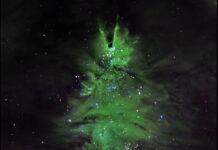Unraveling the Mysteries of NGC 4694: A Cosmic Collision Revealed by Hubble
The universe is a vast and intricate tapestry of celestial bodies, each with its own unique story. Among these is NGC 4694, a galaxy whose peculiar characteristics have captured the attention of astronomers. Thanks to the Hubble Space Telescope, we now have a clearer understanding of this fascinating galaxy and the events that have shaped it.
NGC 4694 is located in the Virgo Cluster, a collection of galaxies that serves as a cosmic laboratory for studying galactic interactions. What sets NGC 4694 apart is its unusual structure, which has long puzzled scientists. This galaxy does not fit neatly into the typical categories of spiral or elliptical galaxies. Instead, it is classified as a lenticular galaxy, a type that lacks the prominent spiral arms seen in spiral galaxies but still features a central bulge and surrounding disk.
One of the most intriguing aspects of NGC 4694 is the chaotic structure of its dust. These irregular formations suggest that some form of disturbance has occurred, and recent observations have provided insights into the nature of this disruption. It turns out that NGC 4694 has undergone a violent collision with a smaller, faint dwarf galaxy known as VCC 2062. This interaction has resulted in the creation of a long bridge of hydrogen gas between the two galaxies.
Collisions between galaxies are not uncommon in the universe. However, they are complex events that can drastically alter the galaxies involved. In the case of NGC 4694, the aftermath of its collision with VCC 2062 has led to the accretion of gas from the smaller galaxy into the larger one. This process has not only influenced the shape of NGC 4694 but also its star-forming activity. The influx of gas has provided the raw material needed for the formation of new stars, contributing to the galaxy’s dynamic nature.
Lenticular galaxies are particularly interesting because they occupy a transitional space between spiral and elliptical galaxies. While they lack the spiral arms, they still contain more star-forming gas than typical elliptical galaxies. This makes them an essential piece of the puzzle when it comes to understanding galactic evolution. NGC 4694, with its unique characteristics, serves as a valuable case study for astronomers seeking to learn more about these enigmatic galaxies.
The Hubble Space Telescope has been instrumental in uncovering the secrets of NGC 4694. Its powerful imaging capabilities allow astronomers to observe galaxies in unprecedented detail, revealing features that would otherwise remain hidden. By studying the structure of NGC 4694’s dust and the distribution of gas, scientists can piece together the history of this galaxy and the forces that have shaped it.
Understanding the nature of galactic collisions and their outcomes is crucial for our broader comprehension of the universe. These events can trigger the formation of new stars, alter the trajectories of galaxies, and even lead to the creation of entirely new structures. By studying NGC 4694 and its interactions with VCC 2062, astronomers gain valuable insights into the processes that govern the cosmos.
For those interested in the technical aspects of this discovery, it’s important to note that the study of galactic interactions often involves analyzing the spectral lines of the gases involved. Spectral lines are akin to fingerprints for elements, revealing their composition, temperature, density, and motion. By examining these lines, astronomers can determine how the gas is moving and interacting within the galaxy.
Moreover, the concepts of accretion and star formation are central to this study. Accretion refers to the process by which a massive body, like NGC 4694, attracts and gathers material from its surroundings, often from smaller bodies like VCC 2062. This material can then form new stars, especially if the conditions are right for star formation, such as having sufficient density and temperature.
In light of this discovery, it’s worth considering how technology like the Hubble Space Telescope has transformed our understanding of the universe. Before the advent of such advanced tools, many of the intricate details of galaxies like NGC 4694 would have remained a mystery. The ability to peer into the depths of space and observe galaxies interacting in real-time has opened up new avenues of research and discovery.
For those who wish to delve deeper into the topic, numerous resources are available that explore the intricacies of galactic dynamics and the role of telescopes in modern astronomy. Websites like NASA’s Hubble site provide a wealth of information and imagery that bring these distant galaxies to life.
In conclusion, NGC 4694 stands as a testament to the dynamic and ever-changing nature of the universe. Its unique characteristics and the story of its collision with VCC 2062 offer a glimpse into the complex interactions that shape galaxies. Thanks to the Hubble Space Telescope, we are able to witness these cosmic events and gain a deeper understanding of the forces that govern the cosmos. As we continue to explore the universe, discoveries like these remind us of the endless mysteries that await our curiosity and scientific inquiry.
For more Information, Refer to this article.


































